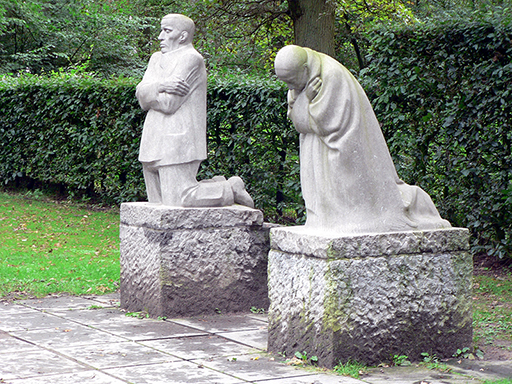4.2 War memorial – Example 2
The second example is ‘The Grieving Parents’, two sculptures by the German artist Käthe Kollwitz.
Käthe Kollwitz lost her only son in October 1914, and expressed her grief in a range of sculptures, drawings and paintings. Completed in 1932, ‘The Grieving Parents’ took Kollwitz 18 years to complete. Today the sculptures are located in Vladslo German war cemetery in Belgium where Kollwitz’s son is buried alongside more than 25,000 German casualties.
Students’ skills development: ‘The Grieving Parents’
When analysing these sculptures, students could be asked to consider the same questions as before:
Answer
Kollwitz designed these sculptures specifically as a memorial to her son Peter, who was killed in the war on 22 October 1914. Rather than choosing to depict her son in the sculpture, however, Kollwitz chose to represent herself and her husband Karl in despairing postures, as if they are grieving at their son’s grave. In doing so, Kollwitz not only expressed the grief within her own family, but also articulated the feelings of countless other parents who had lost sons in the war.
Answer
This memorial is particularly valuable as a record of the personal grief caused by the war. Most of the victims in the war were young men, and the sculptures remind us that many of those most deeply affected by grief were the parents of the dead. Kollwitz’s son’s remains were placed in a common grave, and this memorial (like many others) fills the need for a focal point which may have offered similar consolation to other grieving parents.
Answer
The memorial does not tell us how other parents responded to the war, and nor does it necessarily reflect state-sanctioned narratives of the conflict. Viewing the sculptures themselves, moreover, does not tell us how other people responded to them or whether they offered any consolation.
Answer
As a personal reflection on grief, ‘The Grieving Parents’ are rather different to official war memorials like the Tomb of the Unknown Warrior. The ‘Grieving Parents’ reflect only Kollwitz’s response to the war, whereas the Tomb of the Unknown Warrior presents a state-sanctioned narrative of the conflict. Though both memorials were designed with the bereaved in mind, the Tomb of the Unknown Warrior presents a patriotic affirmation of the war effort, with the aim of offering consolation to the bereaved whilst also reinforcing the legitimacy of the nation and its empire. ‘The Grieving Parents’, on the other hand, offers no such consolation – it is a narrower, more personal response to the war, devoid of any patriotic sentiment.

